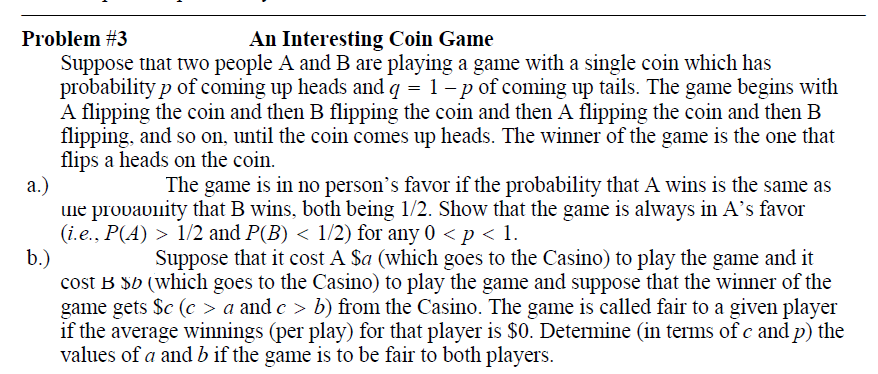Problem #3 An Interesting Coin Game Suppose that two people A and B are playing a game with a single coin which has probability p of coming up heads and q = 1 – p of coming up tails. The game begins with A flipping the coin and then B flipping the coin and then A flipping the coin and then B flipping, and so on, until the coin comes up heads. The winner of the game is the one that flips a heads on the coin. а.) uie provaviity that B wins, both being 1/2. Show that the game is always in A’s favor (i.e., P(A) > 1/2 and P(B) < 1/2) for any 0 < p < 1. b.) cost B $6 (which goes to the Casino) to play the game and suppose that the winner of the game gets Sc (c > a and c > b) from the Casino. The game is called fair to a given player if the average winnings (per play) for that player is $0. Determine (in terms of c and p) the values of a and b if the game is to be fair to both players. The game is in no person's favor if the probability that A wins is the same as Suppose that it cost A $a (which goes to the Casino) to play the game and it
Problem #3 An Interesting Coin Game Suppose that two people A and B are playing a game with a single coin which has probability p of coming up heads and q = 1 – p of coming up tails. The game begins with A flipping the coin and then B flipping the coin and then A flipping the coin and then B flipping, and so on, until the coin comes up heads. The winner of the game is the one that flips a heads on the coin. а.) uie provaviity that B wins, both being 1/2. Show that the game is always in A’s favor (i.e., P(A) > 1/2 and P(B) < 1/2) for any 0 < p < 1. b.) cost B $6 (which goes to the Casino) to play the game and suppose that the winner of the game gets Sc (c > a and c > b) from the Casino. The game is called fair to a given player if the average winnings (per play) for that player is $0. Determine (in terms of c and p) the values of a and b if the game is to be fair to both players. The game is in no person's favor if the probability that A wins is the same as Suppose that it cost A $a (which goes to the Casino) to play the game and it
Algebra for College Students
10th Edition
ISBN:9781285195780
Author:Jerome E. Kaufmann, Karen L. Schwitters
Publisher:Jerome E. Kaufmann, Karen L. Schwitters
Chapter3: Polynomials
Section3.S: Summary
Problem 3S
Related questions
Concept explainers
Contingency Table
A contingency table can be defined as the visual representation of the relationship between two or more categorical variables that can be evaluated and registered. It is a categorical version of the scatterplot, which is used to investigate the linear relationship between two variables. A contingency table is indeed a type of frequency distribution table that displays two variables at the same time.
Binomial Distribution
Binomial is an algebraic expression of the sum or the difference of two terms. Before knowing about binomial distribution, we must know about the binomial theorem.
Topic Video
Question

Transcribed Image Text:Problem #3
An Interesting Coin Game
Suppose that two people A and B are playing a game with a single coin which has
probability p of coming up heads and q = 1 - p of coming up tails. The game begins with
A flipping the coin and then B flipping the coin and then A flipping the coin and then B
flipping, and so on, until the coin comes up heads. The winner of the game is the one that
flips a heads on the coin.
a.)
une provaviity that B wins, both being 1/2. Show that the game is always in A's favor
(i.e., P(A) > 1/2 and P(B) < 1/2) for any 0 < p < 1.
b.)
cost B $b (which goes to the Casino) to play the game and suppose that the winner of the
game gets $c (c > a and c > b) from the Casino. The game is called fair to a given player
if the average winnings (per play) for that player is $0. Determine (in terms of c and p) the
values of a and b if the game is to be fair to both players.
The game is in no person's favor if the probability that A wins is the same as
Suppose that it cost A $a (which goes to the Casino) to play the game and it
Expert Solution
This question has been solved!
Explore an expertly crafted, step-by-step solution for a thorough understanding of key concepts.
This is a popular solution!
Trending now
This is a popular solution!
Step by step
Solved in 7 steps

Knowledge Booster
Learn more about
Need a deep-dive on the concept behind this application? Look no further. Learn more about this topic, probability and related others by exploring similar questions and additional content below.Recommended textbooks for you

Algebra for College Students
Algebra
ISBN:
9781285195780
Author:
Jerome E. Kaufmann, Karen L. Schwitters
Publisher:
Cengage Learning

Intermediate Algebra
Algebra
ISBN:
9781285195728
Author:
Jerome E. Kaufmann, Karen L. Schwitters
Publisher:
Cengage Learning

Algebra for College Students
Algebra
ISBN:
9781285195780
Author:
Jerome E. Kaufmann, Karen L. Schwitters
Publisher:
Cengage Learning

Intermediate Algebra
Algebra
ISBN:
9781285195728
Author:
Jerome E. Kaufmann, Karen L. Schwitters
Publisher:
Cengage Learning